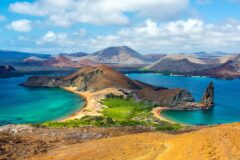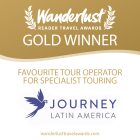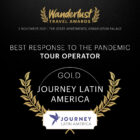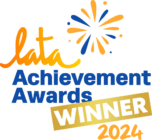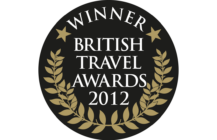Private Journeys
Argentina Wildlife: Tropical wetlands and Patagonia
12 days
from £6,850pp

Overview & Highlights
Spot caimans, giant storks, toucans penguins, sea lions and exceptional sea bird colonies on this wildlife holiday.
- Buenos Aires: City tour
- Iberá Wetlands: Wildlife spotting expeditions from lodge
- Bahía Bustamente: Visits to penguin and seabird colonies
The vast and varied territory of Argentina is home to a huge variety of observable wildlife. This holiday contrasts two of the country’s most important ecosystems, revealing the sub-tropical Iberá wetlands of the north, and the southern Atlantic coastal steppes and islets: Atlantic Patagonia. Relatively hard to reach, these regions make it on to relatively few itineraries and reward visitors with a truly authentic taste of this vast and varied country.
From Buenos Aires, head north to a lodge in the serene Iberá wetlands, where during boat excursions on the lagoons you may spot exotic birds and giant storks, mammals such as the comical capybara, marsh deer, perhaps even howler monkeys as well as alligators. This is remote Argentina; an atmospheric land of rutted roads, sunsets and shimmering reflections. Stay for 3 days on the shores of Laguna Iberá, ideally positioned for wildlife viewing activities.
It’s a dramatic change of scene when you arrive in Patagonia, a wilderness of windswept grasslands, craggy cliffs and Atlantic beaches and host to extraordinary colonies of penguins, sea lions and endemic sea birds which inhabit the off-shore islets alongside the utterly remote seaweed-collecting community of Bahia Bustamante. 4 nights are spent in comfy cottages on a vast private reserve, where you’ll be among the only visitors for miles around.
Our Argentina Wildlife holiday is available between October and March. If you’re travelling in October or November, consider extending your stay to visit the Valdes Peninsula, 5 hours north of Bahia Bustamante, where southern right whales can be easily spotted spouting and frolicking in the Golfo Nuevo.
Outline itinerary
Day 1
Arrive in Buenos Aires. Transfer to your hotel in the Recoleta district.
Day 2
Guided city tour.
Day 3
Fly to Posadas in the northwest and continue to the Iberá wetlands.
Days 4-5
Guided expeditions in the Iberá Wetlands from the lodge.
Day 6
Transfer to Posadas airport and fly to Buenos Aires.
Day 7
Fly to Comodoro Rivadavia in Patagonia; by road to Bahia Bustamante
Days 8-10
Guided excursions at Bahia Bustamante
Day 11
By road and air to Buenos Aires
Day 12
Transfer to the international airport in Buenos Aires.
Itinerary
Day 1
Arrive in Buenos Aires. Transfer to your hotel in the Recoleta district.
You will be met at the airport and escorted to your hotel in the affluent Recoleta district by one of our local representatives.
Buenos Aires is an elegant, cultured and cosmopolitan city famed for its interesting museums and the fascinating port district of La Boca, with its cobbled streets and brightly painted houses. It was here that the tango was born, and Diego Maradona honed his footballing skills.
The centre of town is home to the colonial heartland, government buildings and churches, as well as chic shopping districts, which have a nostalgic Parisian feel. The bohemian quarter of San Telmo is full of quaint old houses interspersed with antiques shops, tango bars and classy restaurants. Slightly further out of the centre is the Recoleta district, even more evocative of the French influence, where Evita Perón was laid to rest.

Day 2
Guided city tour.
Your guided city tour takes you along Avenida 9 de Julio, one of the widest boulevards in the world and studded by the Obelisk, an emblematic symbol of the city. Along this majestic highway is the 19th century Teatro Colón which, in terms of its architecture and design, as well as its excellent acoustics, is considered one of world’s best. On to the Plaza de Mayo, enclosed on 3 sides by the metropolitan cathedral, the town hall and the Casa Rosada, the presidential palace.
The tour continues to bohemian, arty La Boca, which was settled and built by Italian immigrants and has streets lined with brightly painted corrugated iron-clad houses. Visit the district of Recoleta.

Day 3
Fly to Posadas in the northwest and continue to the Iberá wetlands.
Fly to Posadas in the northwest. From there it’s a 4-5hr drive to your lodge in the Esteros de Iberá.
This is a vast wilderness wetland in the province of Corrientes, about half the size of Wales. The open grasslands and marshes afford wonderful birding and wildlife viewing opportunities, especially near the lagoon. The region is home to caiman, capybaras, otters, howler monkeys and over 350 species of birds.

Days 4-5
Guided expeditions in the Iberá Wetlands from the lodge.
Your lodge is on the shores of the Iberá Lagoon and is an ideal base in which to view a wide array of South American wildlife visible in the open country of the marshy wetlands. There are daily opportunities to go bird-watching on the lagoon. Excursions are made by motorised boat, canoe or on foot. Horse-riding with a wildlife guide can be organised at extra cost.

Day 6
Transfer to Posadas airport and fly to Buenos Aires.
The 4-5 hr journey back to Posadas offers more opportunities for sightings along the way. You may catch a glimpse of a snake crossing the red-earth road, birds in technicolour flight or a stationary stork. The flight to Buenos Aires takes 2 hours; upon arrival you will be met and transferred to your hotel in Recoleta for one night.

Day 7
Fly to Comodoro Rivadavia in Patagonia; by road to Bahia Bustamante
Fly from Buenos Aires to Comodoro Rivadavia, a naval port in southern Patagonia. Continue directly by road for around 3 hours to Bahia Bustamante.
Far off the beaten track, the remote settlement of Bahía Bustamante was founded in 1952 by a family who ear-marked this stretch of Patagonian coastline for extracting colloids from seaweed. The bay soon developed into a small village including a school, boatyard, garage and church. At its peak, it was home to 400 people whose lives revolved around the harvesting of seaweed. During the 1990s business slowed and most of the inhabitants moved away. However in 2004, a member of the original family returned and revived the settlement creating an eco-village of 40 residents, focussing on the area’s marine wildlife, self-sufficient in food and electricity, and the farming of seaweed.
Guest lodging is within oceanfront houses, originally workers’ cottages which have been remodelled as down-to-earth yet very comfortable guest accommodation. Two blocks away is the grocery store where meals are served based on local produce including lamb, guanaco, fish, seafood and of course seaweed. There is a games room, small museum, cosy bar and a living room with plenty of interesting books about Patagonia, local wildlife and the seaweed industry. Penguins and sea lions can even be seen swimming from the restaurant.

Days 8-10
Guided excursions at Bahia Bustamante
Bahia Bustamante offers a taste of authentic Patagonia in one of Argentina’s long-forgotten corners. The area has an incredible biodiversity and is rich in seabirds and marine life including the endemic Patagonian steamer duck, Magellanic penguins and a large population of sea lions. 100,000 penguins reside on the offshore islands in peak season (penguins are present between late September and the middle of March). Maras, guanacos and choikes (rhea) are widespread.
It is very peaceful and a wonderful place for nature lovers. Activities which can be organised include boat trips to view sea lions and penguins, horse-riding, a trip to a petrified forest, visiting a Patagonian ranch (with opportunities in season to get involved in shearing, weaning and marking sheep), trekking and mountain biking. There are also secluded sandy beaches to enjoy. It’s very easy to fill a 4 night stay here and what makes the whole experience extra special is being a private reserve there’s practically no one else there.

Day 11
By road and air to Buenos Aires
Farewell to the translucent shores and empty Patagonian steppe of Bahia Bustamante before your transfer back to Comodoro Rivadavia and flight to Buenos Aires. Upon arrival our local staff will meet you to transfer you to your hotel.

Day 12
Transfer to the international airport in Buenos Aires.
Essentials
Tour info
Transport
4 flights (longest 3hrs); 4 scenic road journeys (longest 5hrs).
Accommodation
Most of the holiday is spent between our two carefully selected wildlife lodges in the Iberá Wetlands and Bahía Bustamente. As one would expect of such remote settings, both are rustic yet very comfortable. With unique locations, excellent hosts and an authentic feel, the accommodation is part of the attraction of this holiday. In Buenos Aires, you’ll stay at an upper-mid range hotel in an area handy for local restaurants, walking and sightseeing.
Meals
Breakfast in Buenos Aires, full board in the Iberá Wetlands and Bahia Bustamante.
Guides
We carefully select our local partners, some of whom we have worked with for over 25 years. Their English-speaking guides understand the expectations of our clients very well, and are consistently singled out for praise by the latter on their return.
Summary Of Nights
12 days, 11 nights: Buenos Aires 2; Iberá wetlands 3; Buenos Aires 1; Bahía Bustamente 4; Buenos Aires 1.
Currency
The unit of currency in Argentina is the Argentine peso.
Daily Spend
A budget of around US$50 per day should cover the cost of meals not included in the holiday itinerary, drinks and the odd souvenir. Eat at the best restaurants and you will pay considerably more.
How To Take It
For our latest currency advice for Argentina please see our FAQs section.
Tipping
Tips are expected and local guides often rely on their tip as a significant proportion of their income.
Most service industry workers will expect a tip of some kind and so it is useful to have spare change for hotel porters, taxi drivers and the like. It is common to leave 10 – 12% in restaurants.
Insurance
Travel insurance is essential.
Details of our recommended policy can be found on our Travel Insurance page.
Airport Taxes
If you have purchased your flights through Journey Latin America, the international departure tax is usually included in the ticket.
Journey Grade
Given the spectacular size of Argentina, there are large distances to cover on this holiday so for some journeys we have used domestic flights.
This holiday is suitable for all able, reasonably fit visitors with an interest in wildlife-spotting. If you are travelling alone or have a disability or other special requirement, please do call us.
Climate
Buenos Aires and the pampa plains have similar weather conditions – they are hottest January-March (very humid with tropical showers, occasionally over 40°C during the day). They can be cold and cloudy July-August, so weather conditions are best for a visit in spring and autumn.
In the Iberá wetlands most rain falls Oct-Apr. Temperatures range from 30°C in January down to 20°C in July. Wildlife can be viewed throughout the year but is more subdued in cooler days in winter (Jun-Aug). However, winter is the only time when sightings may occur of neo-tropical otter and yellow anaconda. Bird-watching is at its best Sep-Mar.
In Atlantic Patagonia wildlife is present throughout the year (sea-lions, elephant seals, dolphins, seabirds). Penguins congregate on the beaches Sept-Mar. Rain falls March-Jul when the temperature dips to 16°C from a high of up to 30°C in summer.
Clothing And Special Equipment
The southern hemisphere summer will be hot, therefore for Buenos Aires take loose-fitting light clothing for maximum comfort at this time. An umbrella is a good idea in case of a tropical shower. Spring and autumn are milder and less predictable.
The Iberá wetlands will be very hot and humid in summer, bring clothing appropriate to safari-style excursions including light trousers and shorts, short and long sleeved shirts (there may be insects) and a wide-brimmed hat. Bring mosquito repellant and sun block.
Appropriate day-to-day wear in Patagonia will vary a little according to season, temperatures range from chilly to hot but the wind often blows so a wind-proof layer will add to your comfort. In the southern winter bring some warm clothing including hat scarf and gloves; a light fleece jacket and a Gore-Tex outer shell is a good combination.
South America’s dress code is in informal in general and you won’t need clothes appropriate for formal dining but you may wish to take some smart casual wear for dining at the estancias or at top of the range restaurants.
Don’t forget your binoculars and a camera with a long lens and large capacity memory cards if you are interested in wildlife photography.
Please get in touch with the office before departure if you have any doubts.
Vaccinations
Preventative vaccinations are recommended against the following: typhoid; yellow fever; polio; tetanus; hepatitis A. You should consult your GP for specific requirements.
You can also find helpful information on the Masta Travel Health website.
Visas
Holders of a full British passport do not require a visa, although passports must be valid for at least 6 months after the trip begins. Anyone with a different nationality should enquire with us or check with the relevant consulate.
If flying to the US, or via the US you will need to fill in your online ESTA application.
What's included in the price
- Services of our team of experts in our London office
- Services of Journey Latin America local representatives and guides
- All land and air transport within Latin America
- Accommodation as specified
- Meals as specified
- Excursions as specified, including entrance fees
Included Excursions
- Buenos Aires: City tour
- Iberá Wetlands: Wildlife spotting expeditions from lodge
- Bahía Bustamente: Visits to penguin and seabird colonies
What's not included in the price
- International flights to Latin America
- Tips and gratuities
- Meals other than specified
- Airport taxes, when not included in the ticket
- Optional excursions
